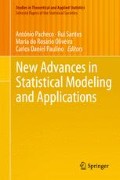Abstract
Group testing, introduced by Dorfman in 1943, increases the efficiency of screening individuals for low prevalence diseases. A wider use of this kind of methodology is restricted by the loss of sensitivity inherent to the mixture of samples. Moreover, as this methodology attains greater cost reduction in the cases of lower prevalence (and, consequently, a higher optimal batch size), the phenomenon of rarefaction is crucial to understand that sensitivity reduction. Suppose, with no loss of generality, that an experimental individual test consists in determining if the amount of substance overpasses some prefixed threshold l. For a pooled sample of size n, the amount of substance of interest is represented by \(\left (Y _{1},\cdots \,,Y _{n}\right )\), with mean \(\overline{Y }_{n}\) and maximum M n . The goal is to know if any of the individual samples exceeds the threshold l, that is, M n > l. It is shown that the dependence between \(\overline{Y }_{n}\) and M n has a crucial role in deciding the use of group testing since a higher dependence corresponds to more information about M n given by the observed value of \(\overline{Y }_{n}\).
Access this chapter
Tax calculation will be finalised at checkout
Purchases are for personal use only
References
Dorfman, R.: The detection of defective members in large populations. Ann. Math. Stat. 14, 436–440 (1943)
Finucan, H.M.: The blood testing problem. Appl. Stat. 13, 43–50 (1964)
Gastwirth, J.L., Johnson W.O.: Screening with cost-effective quality control: potential applications to HIV and drug testing. J. Am. Stat. Assoc. 89, 972–981 (1994)
Hung, M., Swallow, W.: Robustness of group testing in the estimation of proportions. Biometrics 55, 231–237 (1999)
Kim, H., Hudgens, M., Dreyfuss, J., Westreich, D., Pilcher, C.: Comparison of group testing algorithms for case identification in the presence of testing errors. Biometrics 63, 1152–1163 (2007)
Liu, S.C., Chiang, K.S., Lin, C.H., Chung, W.C., Lin, S.H., Yang, T.C.: Cost analysis in choosing group size when group testing for potato virus Y in the presence of classification errors. Ann. Appl. Biol. 159, 491–502 (2011)
Parrish, R.S.: Computing variances and covariances of normal order statistics. Commun. Stat. Simul. Comput. 21, 71–101 (1992)
Santos, R., Pestana, D., Martins, J.P.: Extensions of Dorfman’s theory. In: Oliveira, P.E., et al. (eds.) Recent Developments in Modeling and Applications in Statistics, pp. 179–189. Studies in Theoretical and Applied Statistics. Selected Papers of the Statistical Societies. Springer, Berlin (2013)
Sobel, M., Elashoff, R.: Group testing with a new goal, estimation. Biometrika 62, 181–193 (1975)
Sobel, M., Groll, P.A.: Group testing to eliminate efficiently all defectives in a binomial sample. Bell Syst. Tech. J. 38, 1179–1252 (1959)
Sterret, A.: On the detection of defective members of large populations. Ann. Math. Stat. 28, 1033–1036 (1957)
Wein, L.M., Zenios, S.A.: Pooled testing for HIV screening: capturing the dilution effect. Oper. Res. 44, 543–569 (1996)
Zenios, S., Wein, L.: Pooled testing for HIV prevalence estimation exploiting the dilution effect. Stat. Med. 17, 1447–1467 (1998)
Acknowledgements
The authors thank the referees for their very useful comments. Research partially sponsored by national funds through the Fundação Nacional para a Ciência e Tecnologia, Portugal—FCT under the project PEst-OE/MAT/UI0006/2011.
Author information
Authors and Affiliations
Corresponding author
Editor information
Editors and Affiliations
Rights and permissions
Copyright information
© 2014 Springer International Publishing Switzerland
About this chapter
Cite this chapter
Martins, J.P., Santos, R., Sousa, R. (2014). Testing the Maximum by the Mean in Quantitative Group Tests. In: Pacheco, A., Santos, R., Oliveira, M., Paulino, C. (eds) New Advances in Statistical Modeling and Applications. Studies in Theoretical and Applied Statistics(). Springer, Cham. https://doi.org/10.1007/978-3-319-05323-3_5
Download citation
DOI: https://doi.org/10.1007/978-3-319-05323-3_5
Published:
Publisher Name: Springer, Cham
Print ISBN: 978-3-319-05322-6
Online ISBN: 978-3-319-05323-3
eBook Packages: Mathematics and StatisticsMathematics and Statistics (R0)

